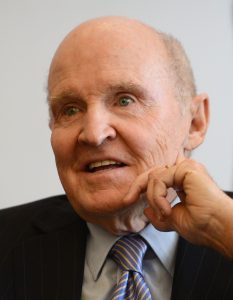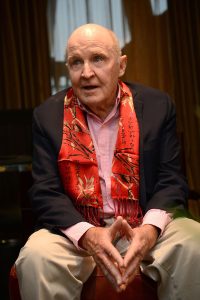Today’s Leadership Styles
by Phyllis Davis
 Today’s leadership styles have changed since Jack Welch’s (1935-2020) rule as Chairman and CEO of General Electric (GE) between 1981 and 2001. In the 1980s, Welch was dubbed “Neutron Jack” (about the neutron bomb) for eliminating employees while leaving buildings intact.
Today’s leadership styles have changed since Jack Welch’s (1935-2020) rule as Chairman and CEO of General Electric (GE) between 1981 and 2001. In the 1980s, Welch was dubbed “Neutron Jack” (about the neutron bomb) for eliminating employees while leaving buildings intact.
[image left, Jack Welch] Jack Welch’s leadership style often falls under autocratic leadership, also known as top-down or command-and-control.
Critical Characteristics of Welch’s Leadership:
- Focus on Performance and Results: Welch prioritized shareholder value and profitability. He implemented a rigorous performance management system, the “rank-and-yank,” where the bottom 10% of employees were routinely fired. This created a high-pressure environment focused on delivering results at any cost.
- Decentralization with Centralized Control: While empowering middle managers to make decisions, Welch ultimately held tight reins on overall strategy and direction. He actively intervened in the businesses, demanding performance and implementing top-down initiatives.
- Ruthless Competitiveness: Welch instilled a culture of “brutal honesty” and fierce competition within the company. He fostered an environment where employees were pitted against each other to achieve results, which could be motivating and detrimental to teamwork.
- Charismatic and Visionary: Despite his autocratic tendencies, Welch was also a charismatic leader with a clear vision for GE’s future. He effectively communicated his goals and inspired employees to strive for greatness, contributing to GE’s significant growth during his tenure.
 The Impact of Welch’s Style:
The Impact of Welch’s Style:
- Short-Term Success: Welch’s leadership undoubtedly led to short-term success for GE. During his 20-year reign, the company’s stock price quadrupled, becoming a global powerhouse.
- Long-Term Challenges: However, his approach also had downsides. The intense pressure and ruthless competition led to employee burnout, decreased morale, and decreased ethical standards. Some argue that GE’s long-term decline after Welch’s departure stemmed from the unsustainable practices and human cost of his leadership style.
- Legacy and Debate: Welch’s legacy remains debatable. Some admire him as a transformational leader who revolutionized corporate America, while others criticize his methods as harmful and unsustainable.
Understanding the Context:
It’s essential to consider the context in which Welch operated. The 1980s and 90s were a period of intense competition and financial pressure for American corporations. His focus on performance and results may have been necessary for survival in that environment.
However, the business world has changed significantly since then. Today, many organizations recognize the importance of fostering employee engagement, creating a positive work environment, and taking a more balanced approach to leadership.
Moving Beyond Welch:
While acknowledging the impact of Welch’s leadership style, it’s crucial to learn from its strengths and weaknesses. Modern leaders should strive for a more sustainable and balanced approach that combines a vision for results with ethical practices, employee well-being, and long-term sustainability.
Remember, leadership is a complex subject with diverse approaches. While Welch’s style may have brought success in his specific context, it’s not a one-size-fits-all model for effective leadership today.
Here are some real-world examples of hybrid leadership with a specific mix of top-down and bottom-up elements that vary depending on the organization. However, these examples highlight the potential of hybrid leadership to strike a balance between control and flexibility, fostering high performance and employee engagement in today’s dynamic business landscape.
- Google’s OKR (Objectives and Key Results) System: This framework blends top-down and bottom-up leadership elements. Executives set ambitious company-wide objectives, but individual teams define their Key Results based on these objectives. This allows for both clear direction and decentralized problem-solving.
- Patagonia’s Activist CEO: Yvon Chouinard, Patagonia’s founder, embodies a hybrid leadership style that combines strong business acumen with environmental activism. He prioritizes profitability and sustainability, making bold decisions like donating profits to environmental causes and shutting down factories with questionable practices.
- Haier’s Rendanheyi Model: This Chinese appliance giant has revolutionized its organizational structure with a hybrid approach. Instead of traditional hierarchies, Haier empowers self-organizing teams called Rendanheyi to make decisions, manage budgets, and compete within the company. This fosters innovation and adaptability while maintaining a strategic vision from the top.

